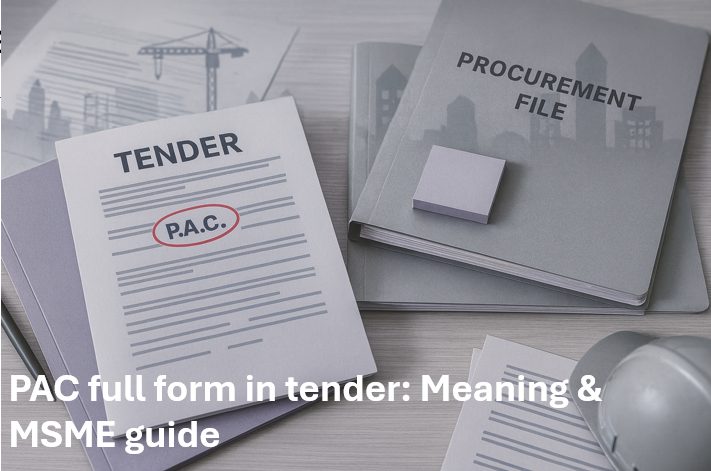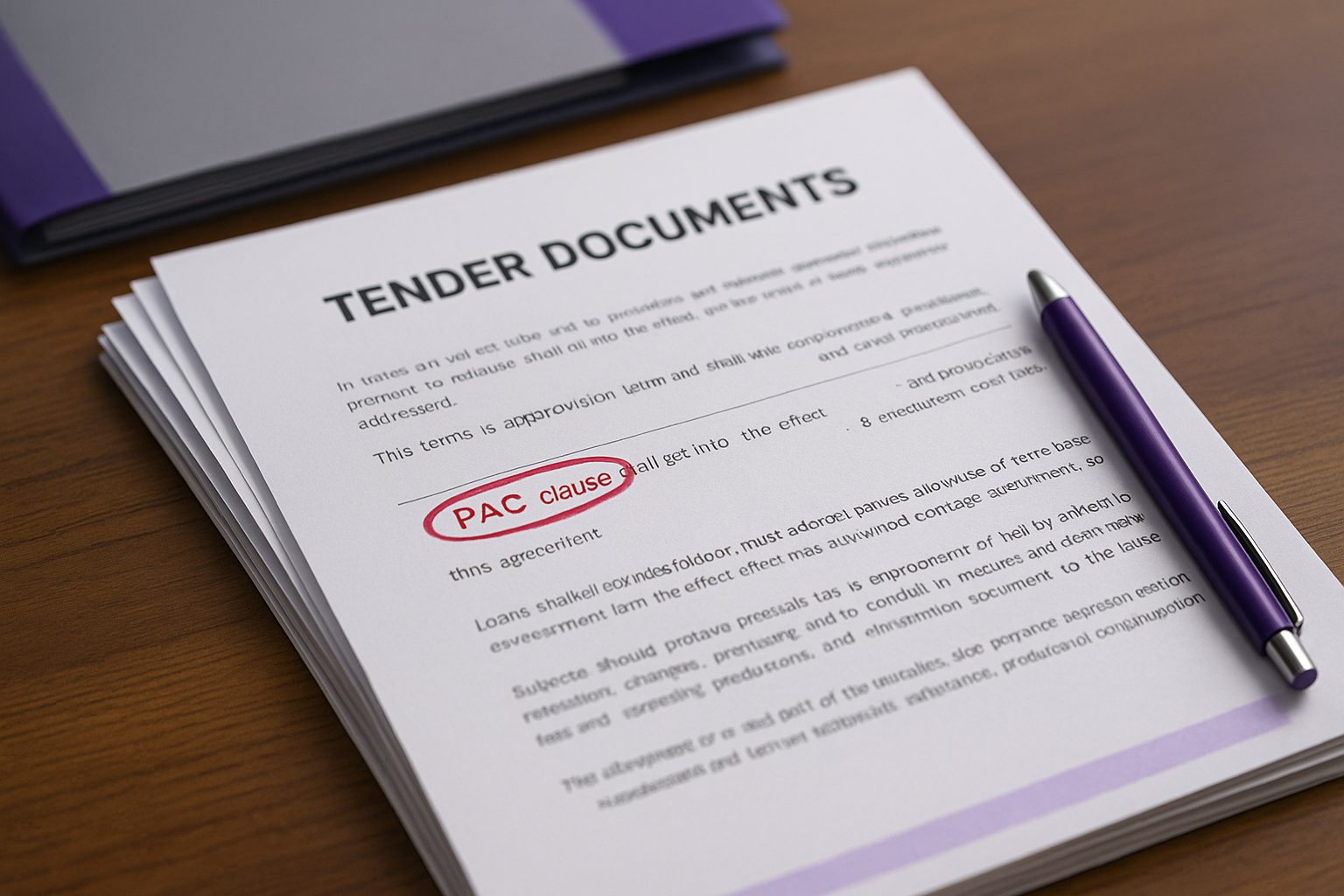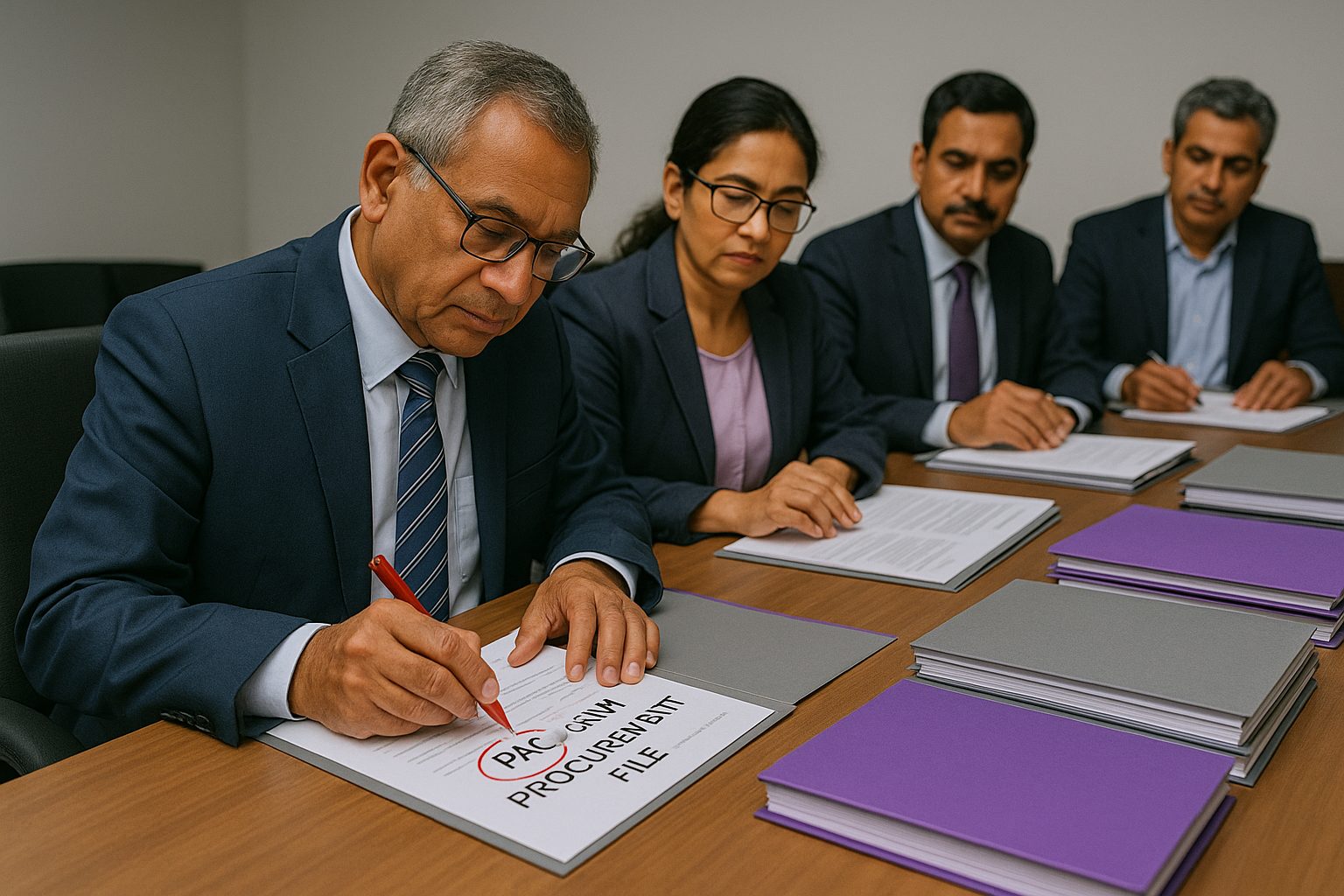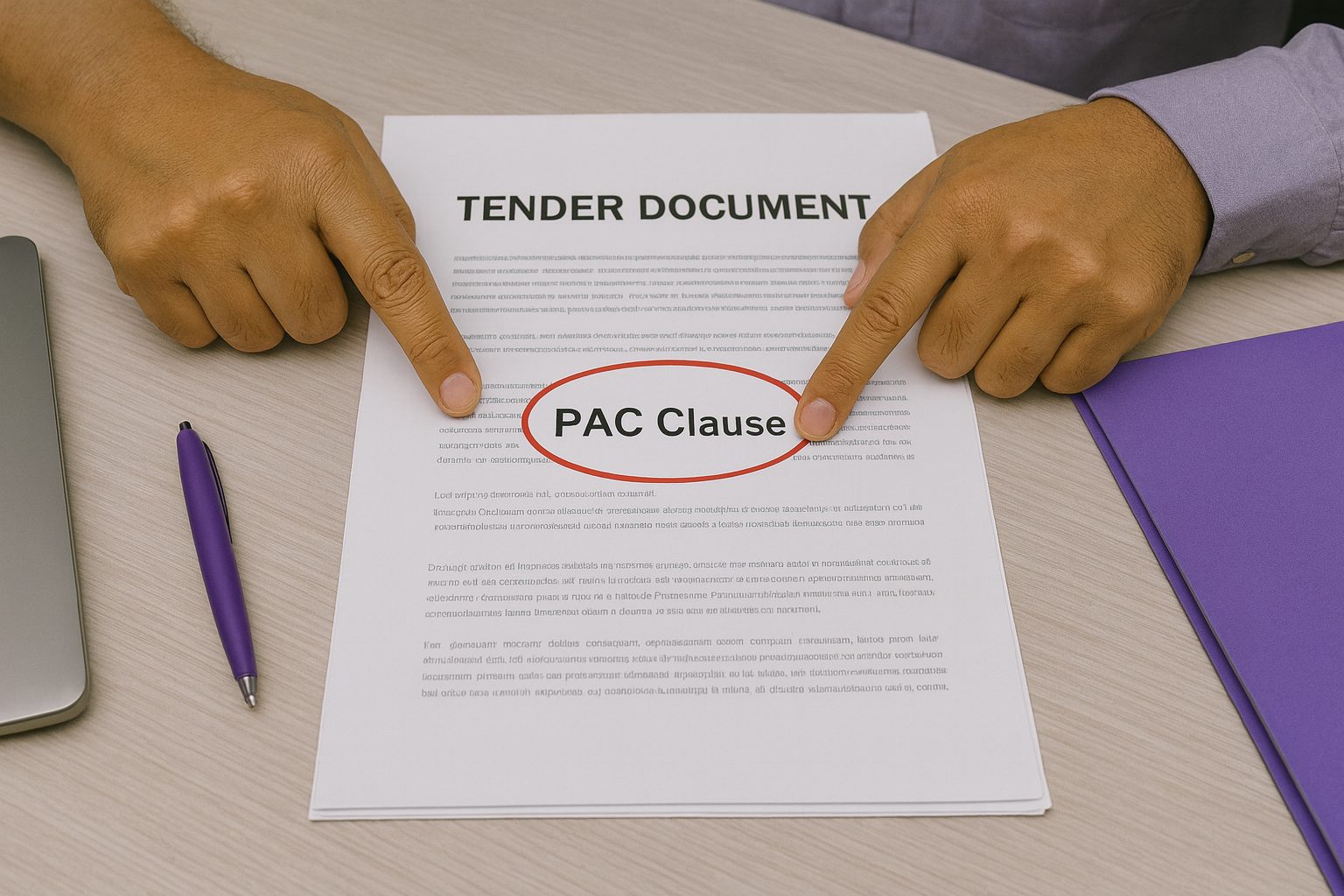Table of Contents
Introduction
Anyone searching for ‘pac full form in tender’ quickly notices a problem: the answer is not the same everywhere. In government procurement, PAC is read as Proprietary Article Certificate. Whereas, in civil work tenders, the same letters stand for Probable Amount of Contract. Both are correct, yet each points to a very different process and set of implications.
For micro and small enterprises, this difference is more than academic. A PAC certificate on GeM can limit a tender to one brand, leaving smaller vendors with little room to compete. A PAC value in a PWD contract fixes the baseline against which bid securities and margins are calculated. Confusing the two can lead to wasted effort, rejected bids, or underpriced offers.
This guide unpacks both meanings with clear examples, highlights the compliance points often missed, and outlines practical steps that MSMEs can use to navigate PAC-linked tenders more effectively.
PAC as Proprietary Article Certificate (Procurement context)
In government buying, PAC full form in tender usually means Proprietary Article Certificate. It is the official note a department issue when it believes only one product or brand can be supplied. The logic is simple: avoid risk by sticking to the original. The effect, however, is that competition is shut out.
Take a common case. A state hospital needs spare parts for imported diagnostic equipment. To avoid breakdowns, the purchase is tied directly to the original manufacturer or its authorised agent. The procurement team invokes PAC and records that no equivalent exists. From the hospital’s perspective, the move is sensible. For smaller firms making compatible spares, it is a locked door.
MSMEs face two choices when such tenders appear. The first is to work upstream by signing dealership or distribution agreements with original makers. The second is to challenge the exclusivity, often by presenting technical certificates or comparison sheets that prove a substitute is viable. Both routes are demanding. Neither can be managed after the notice is out; preparation has to happen earlier.
What many overlook is the PAC justification note. This is the file where the buyer defends the decision, citing safety, warranty or standardisation. Vendors who study how these notes are written gain a clear view of what arguments are accepted. That knowledge can shape future bids and even open chances to contest a restrictive call.
For smaller businesses, PAC in procurement is not just a definition in a rulebook. It is a signal that strategy matters. Recognising it early helps decide whether to partner, to contest, or to walk away before wasting resources.
PAC as Probable Amount of Contract (Civil works context)
In public works departments, PAC full form in tender is read as Probable Amount of Contract. It is the cost the department believes a project will take, worked out by engineers long before a bid is released. On paper it looks like a simple estimate. In practice it shapes everything that follows – the earnest money, the performance guarantee, even how “reasonable” a contractor’s quote appears to the evaluation team.
Take a ₹25L building repair job. If the PAC is set at that figure, bidders are asked to deposit a fixed percentage upfront. That money sits locked until the contract closes. For a small contractor, often juggling multiple sites with limited credit – the size of the PAC becomes the first hurdle. Too high, and cash flow dries up. Too low, and the bid itself turns risky.
The irony is that PAC values are not always rooted in today’s market. Departments rely on schedules of rates that may be updated once a year, sometimes less. Cement may have jumped in price, or steel transport may have doubled due to fuel hikes. None of that is visible in the PAC line. Contractors on the ground then face a hard choice: chase the work and cut margins or walk away and preserve capital.
Veterans treat PAC as a signal, not a guarantee. They run their own calculations, add local freight, and decide whether the job is still viable. If the gap is wide, the safer call is to skip. For MSMEs, this judgment is critical. Reading the PAC carefully at the start often saves months of strain later.
How MSMEs should navigate PAC-only tenders
For many smaller suppliers, seeing a PAC certificate on a tender feels like the end of the road. The department has already decided that only one brand or make will do. In truth, it narrows the playing field, but it doesn’t always close it. Here are a few ways or alternatives to prepare for the future.
Working with OEMs
Most PAC tenders name the original maker, but they often accept bids through authorised dealers too. That is where MSMEs can find space. Firms that have already built ties with OEMs – as service partners, distributors, or stockists – stand a chance of qualifying. It takes advance effort. No dealer agreement can be stitched together overnight once the tender is live.
Challenging exclusivity
There is also the option of challenging the PAC itself. Authorities must explain why competition is being set aside. If a small manufacturer has credible evidence – certifications, lab reports, or even previous supply records – it can submit these for consideration. Results vary. Sometimes the file moves on unchanged. Other times, objections force a review. Even when it doesn’t succeed, the protest leaves a paper trail that may help in the future.
Moving quickly
The toughest part is time. PAC tenders progress fast. Once the justification is cleared, objections rarely carry weight. That means monitoring portals daily, spotting PAC notices early, and responding before the window shuts. Many MSMEs lose out simply because they react too late.
In short, PAC tenders are not easy, and they rarely bend in favour of smaller firms. Yet the businesses that prepare
–By cultivating OEM ties,
–By building a bank of technical evidence, and
–By staying alert,
they give themselves a fighting chance. For everyone else, PAC is not a barrier, it is a warning sign: change your strategy or be left behind.
Compliance & Documentation essentials for PAC
Every PAC tender rests on paperwork. For buyers, it is the justification they must record. For vendors, it is the evidence they must provide if they want a chance to be heard. Missing or weak documents can sink a case before it even reaches evaluation.
What buyers record
When a department invokes a PAC, officials are required to prepare a justification note. This file explains why competition was restricted – whether for safety, standardisation, or technical fit. It usually includes product specifications, market checks, and approval from a competent authority. Auditors often go back to these notes. If the reasoning is thin, the buyer risks questions later.
What vendors should watch
For MSMEs, understanding how these notes are written is half the battle. If a firm knows that “no alternatives exist” is the standard line, it can counter with certifications or past supply records that prove otherwise. Technical brochures, NABL test results, or compliance with BIS standards are powerful inserts. Many small firms fail because they submit generic catalogues instead of precise evidence.
Why timing matters
Documentation has weight only if submitted on time. Once a PAC note is approved and uploaded, challenges rarely succeed. Vendors who prepare a ready folder of certificates, performance reports, and authorisation letters have a far better chance when a restricted tender surfaces.
In the world of PAC tenders, rules are written to protect the buyer, not the seller. That makes paperwork the only tool a smaller business has to press its case. Strong documents may not guarantee entry, but weak ones almost always guarantee rejection. For MSMEs trying to stay visible in restricted markets, compliance is not a burden. It is the only lever they can pull.
Other PAC Meanings in Contracts (For Awareness)
The letters PAC cause plenty of confusion because they don’t mean the same thing everywhere. Outside procurement files, contractors on big infrastructure jobs use the term for something else entirely: the Provisional Acceptance Certificate
On site, this PAC is less about tenders and more about handover. Once the bulk of the work is finished, and the project can safely start running, the client issues a provisional acceptance. A new power substation may be energised even if the fencing isn’t up yet. A treatment plant may begin operating while painting or landscaping drags on. The document allows the owner to use the asset while the contractor closes out minor jobs.
For small vendors plugged into these projects, this stage can decide cash flow. Payments often hinge on provisional acceptance. So do warranties. Miss the significance of the date, and a supplier can either delay invoicing or start the warranty clock too late. Both hurt.
The tricky part is the overlap. Procurement officers and site engineers both talk about “PAC,” but they are not speaking the same language. One certificate limits competition. The other marks provisional handover. MSMEs that straddle supply and execution need to spot the difference instantly. Getting it wrong can hold up payments or trigger disputes that drag for months.
Conclusion
The search for pac full form in tender doesn’t lead to one neat answer. In procurement, it is a Proprietary Article Certificate, used when only one brand can be bought. Whereas, in civil works, it is the Probable Amount of Contract, the figure that sets deposits and bid values. Also, in project execution, it appears again as the Provisional Acceptance Certificate, the signal that an asset can start running. Same letters, very different implications.
For MSMEs, these distinctions are not just academic. A PAC clause on GeM decides who gets to bid, and a PAC value in a road contract stretches working capital before a brick is laid. On site, a PAC document releases long-pending payments or starts warranty periods. If you confuse one for the other, you block cash, lock up guarantees, or trigger disputes.
The lesson is simple but often missed: never skim past “PAC” in a tender or contract. Pause and ask which PAC it is, what role it plays, and how it touches your business. The answer could save weeks of paperwork and lakhs in capital. For small firms fighting for space in public procurement, that clarity is not a luxury. It is survival!
Looking for the right government tenders for your business?
Tata nexarc helps MSMEs, manufacturers, and service providers find relevant government tenders across India. Discover tenders by location, category, or department, track deadlines, and get notified on time — with complete support to help you apply confidently.
FAQs
FAQ title Does PAC buying override preference for local suppliers?
What costs creep in when chasing OEM authorisation?
How should service be priced in restricted PAC bids?
Can a weak PAC note stall a tender?
How does PAC value shape finance for contractors?
What levers remain in a single-brand tender?
Why does Provisional Acceptance matter to subcontractors?
Can pre-bid meetings soften a PAC clause?
How do SMEs handle outdated PAC rates in works contracts?
What files should SMEs maintain for PAC disputes?
Charul is a content marketing professional and seasoned content writer who loves writing on various topics with 3 years of experience. At Tata nexarc, it has been 2 years since she is helping business to understand jargon better and deeper to make strategical decisions. While not writing, she loves listing pop music.













